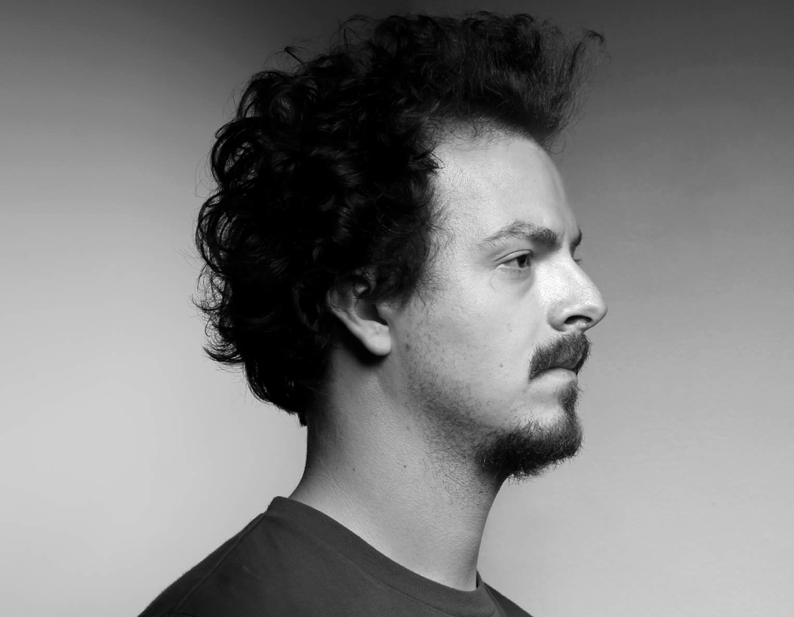Q&A: Graphic artist David Wexler on media, design and Strangeloop

Graphic designer David Wexler, who creates set designs for artists such as Flying Lotus, Erykah Badu and Skrillex, will give a talk as part of Design | Media Arts’ lecture series Thursday. (Courtesy of Theo Themison)
By Daniel Alcazar
Jan. 26, 2016 8:21 a.m.
The following sentence is false. The previous sentence is true. This self-referential paradox that cognitive scientist and philosopher Douglas Hofstadter describes as a “strange loop,” a phenomenon that occurs when one moves through real or imagined levels, but unexpectedly arrives where he or she started.
The works of David Wexler, a graphic artist who also goes by the stage name Dr. Strangeloop, are directly inspired by Hofstadter’s analyses of infinitely recurring objects in his set designs for Flying Lotus, Erykah Badu and the Rolling Stones.
Wexler will give a talk for the Design | Media Art’s lecture series Tuesday, where he will step from behind the scenes to the Broad stage to discuss form of media and design.
The Daily Bruin’s Daniel Alcazar spoke with Wexler, who was in the middle of rehearsals for EDM artist Flume’s Australian tour, about his education, collaboration when creating visual shows and why his upcoming talk is meaningful to him.
Daily Bruin: Where does the name “Strangeloop” come from?
David Wexler: I’ve always loved loops, specifically “strange loops,” infinite recursive sequences, stuff that you see in the work of artists like M.C. Escher … Video feedback loops are a great way of getting a visceral impression of “strange loops,” and when I was a kid it was one of the fundamentally mesmerizing effects that got me into working with video.
DB: Can you preview your talk?
DW: I want to talk about media, I want to demonstrate the kind of expressiveness that you can exhibit nowadays in working with media live and I want to discuss in more detail my journey into the specific realm of design and art that I find myself in currently. I also want to talk about my grandfather, Haskell Wexler, who passed away recently. He was a very important person in my life, and I know many other people’s lives. He had a very good relationship with UCLA, and I feel that if I am going to be there, I really want to honor that.

DB: Can you talk about any upcoming projects?
DW: I am working on a living archive project of all my drawings and paintings. I am building a new site for distributing visual content, working on a film with E. Elias Merhige, finishing a music video for Daedelus and Kneebody with Gavin Gamboa, and also lots of exciting stuff that I’m actually not sure that I can talk about.
DB: Are you a self-taught artist?
DW: I’ve always made art, but I did go to film school for a year at the Academy of Art University in San Francisco and studied video installation and “mystical states” in Santa Monica College. Whatever that means. I think making my own major was my way of focusing in more directly on what really interested me in art and design. I guess I am primarily self-taught, but I’ve had a lot of great mentors, people like Leigh McCloskey (and) E. Elias Merhige, and I’m very lucky to be surrounded by a lot of incredible artists that challenge me and teach me things all the time.
DB: What sort of themes and ideas influence your work?
DW: Loops, science fiction, altered states, cosmic pessimism, natural patterns, infinite complexity, iterated stroboscopic patterns of hyper-dimensional geometry. Hyper-reality, simulations, artificial intelligence, dreams, are also very important (to my work).
DB: What is the collaboration process like when working with other artists?
DW: At this stage in my career, I collaborate with a lot of different musicians on creating visual shows. Sometimes, there is a lot of direct communication with the musician, but more often than not I’m collaborating with a lot of different artists and engineers surrounding the musician to create something that visually reflects their sound, their iconography, their universe. The process can be radically different depending on the show, but involves a lot of the same tools you might employ if you were making a film, storyboards, pre-visualization, design, editing.
Though there seems to be an added freedom in the form, in that it hasn’t been around as long as cinema, there is more of a willingness to break conventions, to combine sound and image in novel ways that can create new types of narrative, or just deal with imagery as pure spectacle, kind of devoid of traditional narrative.
DB: What is your most memorable collaboration?
DW: Not sure I could say. Flying Lotus, Gaslamp Killer, Skrillex, The Weeknd – all have been very memorable experiences, and I definitely take something different away from any artist I get to collaborate with.
DB: What’s the last song you listened to?
DW: Flume’s “Holdin On” … 27 times.
Compiled by Daniel Alcazar, Daily Bruin senior staff.


